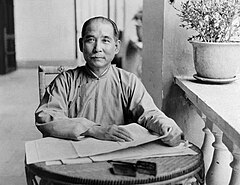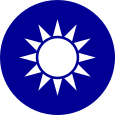Chiangism
This article needs additional citations for verification. (September 2023) |

| Part of a series on |
| Three Principles of the People |
|---|
 |
|
| Part of a series on |
| Conservatism in China |
|---|
|
 |
|---|
|
|
Chiangism (
The extent of the influence of
History
The socialist ideology of the Kuomintang was one of the ideologies which greatly influenced this philosophy. In the West, Chiang Kai-shek was hailed as one of the world's greatest socialist leaders. His portraits were carried along with portraits of Karl Marx, Vladimir Lenin, Joseph Stalin, and other socialist and communist leaders. Chiang Kai-shek would soon be an enemy of the CCP in the Chinese Civil War in trying to counter the rebellion started by his rival, Mao Zedong and his more successful ideology: Maoism.
Unlike Sun's original
The Kuomintang government under Chiang Kai-shek denounced feudalism as counterrevolutionary and proclaimed itself to be revolutionary. He accused other Chinese warlords of being feudalists. Despite being a conservative ideology, Chiangism supported modernization policies such as women's rights, scientific advancement, and universal education.
The Kuomintang and the
Doctrine
Chinese nationalism and anti-imperialism
Chiang Kai-shek, the head of the Kuomintang, warned the Soviet Union and other foreign countries about interfering in Chinese affairs. He was personally angry at the way China was treated by foreigners, mainly by the Soviet Union, Britain, and the United States.[12] Chiang's New Life Movement campaigned for the end of Soviet, Western, American, and other foreign influences in China. Chen Lifu, a CC Clique member of the KMT, said, "Communism originated from Soviet imperialism, which has encroached on our country." It was also noted that "the white bear of the North Pole is known for its viciousness and cruelty."[13]
Chiang was also staunchly against imperialism and colonialism, as he opposed FDR's offer of China's seizure of
Authoritarian capitalism and dirigisme
After the government of the Republic of China moved to Taiwan, Chiang Kai-shek's economic policy turned towards to economic liberalism. He used Sho-Chieh Tsiang and other liberal economists to promote economic liberalization reforms in Taiwan.[17]
However, Taylor has noted that the developmental model of Chiangism in Taiwan still had elements of socialism, and the Gini index of Taiwan was around 0.28 by the 1970s, lower than the relatively equal
After the democratization of Taiwan, it began to slowly drift away from the Chiangist economic policy to embrace a more free market system as part of the economic globalization process under the context of neoliberalism.[21]
Anti-communism and fascism
The
Chiang Kai-shek started the
Some historians regard this movement as imitating Nazism and regard this movement as being a neo-nationalistic movement used to elevate Chiang's control of everyday lives. Frederic Wakeman suggested that the New Life Movement was "Confucian fascism",[23] However, Chiang repeatedly attacked his enemies such as the Empire of Japan as fascistic and ultra-militaristic.[24][25] The Sino-German relationship also rapidly deteriorated as Germany failed to pursue a detente between China and Japan, which led to the outbreak of the Second Sino-Japanese War. China later declared war on fascist countries, including Germany, Italy, and Japan, as part of the Declarations of war during World War II.
Other historians, such as Jay Taylor, argue that Chiang's ideology does not espouse the general ideology of fascism despite his growing sympathies with fascist ideas in the 1930s.[18]
The military played a large role in China's government during Chiang's rule, with the National Revolutionary Army under direct control of the Kuomintang until 1946.[citation needed]
Anti-capitalism and revolutionary nationalism
The Kuomintang was a Chinese nationalist revolutionary party that had been supported by the Soviet Union. It was organized on Leninism.[26] Contrary to the view that he was pro-capitalist, Chiang Kai-shek behaved in an antagonistic manner to the capitalists in China, often attacking them and confiscating their capital and assets for the use of the government.
Chiang cracked down on pro-communist unions and peasant organizations, and the wealthy Shanghai capitalists at the same time. Chiang Kai-shek continued Sun's anti-capitalist ideology. The Republic of China's media openly attacked the capitalists and capitalism, supporting a government-controlled economy instead of privately owned ones.
Jay Taylor has noted that Chiang's hybrid
See also
References
- S2CID 144316615.
- JSTOR 652110. Retrieved 2 February 2021.
- ^ "Second Sino-Japanese War | Summary, Combatants, Facts, & Map | Britannica". Britannica.com. Retrieved 2022-05-19.
- .
- ^ "Chinese Civil War | Summary, Causes, & Results | Britannica". Britannica.com. Retrieved 2022-05-19.
- ^ Yat-sen, Sun. "San Min Chu I: The Three Principles of the People" (PDF). Chinese.larouchepub.com. Retrieved 2022-07-23.
- ^ "禁纏足、興女學:南京國民政府在興女權上做出巨大努力 - 雪花新闻". Xuehua.us. Retrieved 2022-07-23.
- ^ Huang, Chang-Ling. "Gender Quotas in Taiwan" (PDF). 2.igs.ocha.ac.jp. Retrieved 2022-07-23.
- ^ "从合礼到非法:纳妾制度在中国是如何被废除的?". Yangtse.com. 2020-06-29. Retrieved 2022-07-23.
- ^ "南京国民政府时期的教育". M.xzbu.com (in Chinese). 2012-09-12. Retrieved 2022-07-23.
- ^ "抗戰前推動「普及教育案」的背景與實際作為 - 大中華民國". Stararctic108.weebly.com. Retrieved 2022-07-23.
- ISBN 0786714840. Retrieved 2010-06-28.
- ISBN 0761811583. Retrieved 2010-06-28.
- ISBN 0195363744. Archivedfrom the original on 26 April 2016. Retrieved 28 June 2014.
- ISBN 0-345-30823-9. Archivedfrom the original on 5 October 2015. Retrieved 28 November 2010.
- ^ "Chiang Kai-shek Quote". Libquotes.com. Retrieved 23 July 2022.
- ISBN 9789570845655.
- ^ ISBN 9780674054714.
- ISBN 0-8204-5010-3. Archivedfrom the original on 27 July 2020. Retrieved 15 May 2011.
- ISBN 0-674-80536-4. Archivedfrom the original on 27 July 2020. Retrieved 15 May 2011.
- ^ "Archived copy" (PDF). Archived from the original (PDF) on 21 April 2018. Retrieved 20 February 2023.
{{cite web}}: CS1 maint: archived copy as title (link) - ^ Schoppa, R. Keith. The Revolution and Its Past (New York: Pearson Prentic Hall, 2nd ed. 2006, pp. 208–209 .
- ^ Wakeman, Frederic, Jr. (1997). “A Revisionist View of the Nanjing Decade: Confucian Fascism.” The China Quarterly 150: 395–432.
- ^ "Archived copy". Archived from the original on 21 April 2021. Retrieved 19 July 2022.
{{cite web}}: CS1 maint: archived copy as title (link) - ^ "Chiang Kai-shek's victory speech in 1945 - YouTube". M.youtube.com. 2013-06-09. Retrieved 2022-07-19.
- ISBN 0786714840. Retrieved 2010-06-28.

